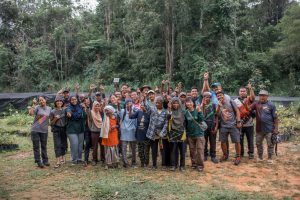As restoration goals ramp up globally, from national reforestation pledges to corporate carbon commitments, one crucial question often goes unasked: where do all the seeds come from? Without a reliable, diverse, and well-coordinated seed supply, forest restoration risks falling short of its ecological promise.
In many restoration projects, seeds are sourced from fragmented networks of informal collectors, under-resourced nurseries, and uncoordinated actors, often with limited attention to genetic diversity, provenance, or ecological fit. Unlike large-scale agriculture, there is no unified system for native seed supply in most countries, including Malaysia. As a result, many restoration efforts rely on opportunistic or low-quality seed sources, which undermines long-term success.
This is a global problem. In Australia, just 10% of native plant species are readily accessible for restoration, with many important understorey shrubs key to maintaining ecosystem diversity remaining largely unavailable. Similar challenges exist in Canada and Brazil, where native tree seed supply meets less than 1% of restoration demand in some regions.
Native plants play a vital role in ecosystem restoration by supporting biodiversity, resilience, and long-term ecological sustainability. However, ensuring a steady, high-quality seed supply remains a global challenge. Economic barriers such as low profitability and high production costs make it difficult for private nurseries to scale up. At the same time, inconsistent demand and a lack of long-term restoration planning create uncertainty for seed producers. While demand for commercial planting is often predictable, sudden restoration needs such as after natural disasters can quickly overwhelm existing seed inventories. Compounding the issue, many nurseries rely on seed collected from a narrow or genetically weak pool, undermining the success of restoration efforts.
The Seed to Tree project tries to address each of these steps by connecting restoration actors with practical tools, data, and each other, including Indigenous and local communities who have long played the role of ecological stewards.
“Lack of genetic diversity considerations in current strategies of seed selection and collection can result in negative consequences not only for individual survival, growth and productivity, but also for the resilience of the restored populations as well as the provisioning of ecosystem services.” – Bosshard et al
Led by the Alliance of Bioversity International & CIAT and TRCRC , and funded by the UK Mission to ASEAN, Seed to Tree aims to improve the availability and quality of native seed supply in Malaysia: an important move for meaningful, long-term forest restoration.

The seed value chain is the journey that native tree seeds take from forest to nursery to planting site. Each step requires care, knowledge, and collaboration:
- Seed Source Identification: Selecting the right mother trees to ensure genetic diversity and ecological fit.
- Collection & Storage: Gathering seeds at the right time and storing them properly to preserve viability.
- Nursery Cultivation: Raising healthy seedlings using the right propagation methods and site-matching tools.
- Distribution & Planting: Ensuring seedlings get to the right place, at the right time, and with proper site preparation.
- Monitoring & Verification: Tracking outcomes to learn what works and support future improvement.
A regional study of tree seed systems in Malaysia, Indonesia, the Philippines, and India found significant bottlenecks in nearly every country, including: low supply of native seed, especially for less-commercial species; weak quality control often leading to poor seedling survival; lack of data on genetic suitability and climate resilience; and fragmented coordination between collectors, nurseries, and restoration implementers.
“With the combined national restoration targets of the Philippines, Indonesia, Malaysia and India of over 47.5 million hectares, successful FLR efforts in these four megadiverse countries alone could contribute to approximately 13% of the global goal of the Bonn Challenge to bring 350 million hectares of degraded and deforested landscapes intorestoration by 2030.” – Bosshard et al
Malaysia in particular was found to have a fragmented, mostly independent or market-driven seed system, with limited national oversight or standardisation. This limits both the volume and quality of seed available for forest landscape restoration (FLR).
“Common gaps in the national seed systems: (i) Existing seed supply is inadequate to match the growing demand for priority native species in terms of both quantity and quality, (ii) quality control for tree seed is typically either lacking or ineffectively implemented and (iii) research into the effects of climate change on native species is still limited and the existing knowledge is not effectively applied to guide seed sourcing and seed zoning strategies.” – Bosshard et al
Aware of these gaps, the Seed to Tree project is supporting the development of a national restoration toolkit to guide species selection based on site suitability and climate projections. It also contributes to improved MRV systems that document seed provenance, quality, and planting outcomes. The project promotes broader community participation, including the involvement of Indigenous seed collectors and nursery operators, while piloting digital tools such as Diversity for Restoration (D4R) to enhance restoration planning with the use of appropriate tree species and seed sources. Multi-stakeholder networks are being established to strengthen coordination and trust throughout the seed value chain.
These efforts align with international recommendations to improve genetic quality, expand sourcing zones, and prioritise native species for biodiversity outcomes and long-term climate adaptation.
Planting trees is not just a numbers game. It’s about planting the right trees, in the right places, with the right support systems in place. A strong, inclusive, and science-informed seed value chain is what turns good intentions into thriving forests.
Bosshard, E., Jalonen, R., Kanchanarak, T., Yuskianti, V., Tolentino Jr., E., Warrier, R. R., Krishnan, S., Dzulkifli, D., Thomas, E., Atkinson, R., & Kettle, C. J. (2021). Are Tree Seed Systems for Forest Landscape Restoration Fit for Purpose? An Analysis of Four Asian Countries. Diversity, 13(11), 575. https://doi.org/10.3390/d13110575
Ground Truth Forest News. (2024, August 15). Tough Nut to Crack: Tree Seed Supply Chains. Medium. https://medium.com/@GroundTruthData/tough-nut-to-crack-tree-seed-supply-chains-20f2d5cf0857
